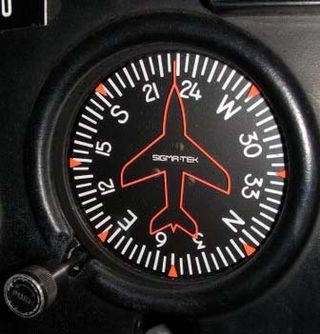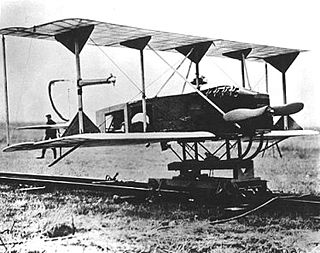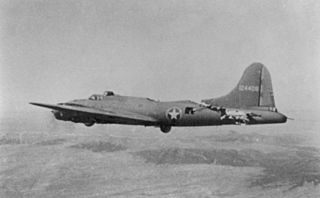Related Research Articles

Fly-by-wire (FBW) is a system that replaces the conventional manual flight controls of an aircraft with an electronic interface. The movements of flight controls are converted to electronic signals transmitted by wires, and flight control computers determine how to move the actuators at each control surface to provide the ordered response. Implementations either use mechanical flight control backup systems or else are fully electronic.

Sperry Corporation was a major American equipment and electronics company whose existence spanned more than seven decades of the 20th century. Sperry ceased to exist in 1986 following a prolonged hostile takeover bid engineered by Burroughs Corporation, which merged the combined operation under the new name Unisys. Some of Sperry's former divisions became part of Honeywell, Lockheed Martin, Raytheon Technologies, and Northrop Grumman.

The heading indicator (HI), also known as a directional gyro (DG) or direction indicator (DI), is a flight instrument used in an aircraft to inform the pilot of the aircraft's heading.

An autopilot is a system used to control the path of an aircraft, marine craft or spacecraft without requiring constant manual control by a human operator. Autopilots do not replace human operators. Instead, the autopilot assists the operator's control of the vehicle, allowing the operator to focus on broader aspects of operations.

Elmer Ambrose Sperry Sr. was an American inventor and entrepreneur, most famous for construction, two years after Hermann Anschütz-Kaempfe, of the gyrocompass and as founder of the Sperry Gyroscope Company. He was known as the "father of modern navigation technology".

The Norden Mk. XV, known as the Norden M series in U.S. Army service, is a bombsight that was used by the United States Army Air Forces (USAAF) and the United States Navy during World War II, and the United States Air Force in the Korean and the Vietnam Wars. It was an early tachometric design that directly measured the aircraft's ground speed and direction, which older bombsights could only estimate with lengthy manual procedures. The Norden further improved on older designs by using an analog computer that continuously recalculated the bomb's impact point based on changing flight conditions, and an autopilot that reacted quickly and accurately to changes in the wind or other effects.

A stabilator is a fully movable aircraft horizontal stabilizer. It serves the usual functions of longitudinal stability, control and stick force requirements otherwise performed by the separate parts of a conventional horizontal stabilizer and elevator. Apart from reduced drag, particularly at high Mach numbers, it is a useful device for changing the aircraft balance within wide limits, and for reducing stick forces.

A fire-control system (FCS) is a number of components working together, usually a gun data computer, a director and radar, which is designed to assist a ranged weapon system to target, track, and hit a target. It performs the same task as a human gunner firing a weapon, but attempts to do so faster and more accurately.

A bombardier or bomb aimer is the crew member of a bomber aircraft responsible for the targeting of aerial bombs. "Bomb aimer" was the preferred term in the military forces of the Commonwealth, while "bombardier" was the equivalent position in the United States Armed Forces.

Trim tabs are small surfaces connected to the trailing edge of a larger control surface on a boat or aircraft, used to control the trim of the controls, i.e. to counteract hydro- or aerodynamic forces and stabilise the boat or aircraft in a particular desired attitude without the need for the operator to constantly apply a control force. This is done by adjusting the angle of the tab relative to the larger surface.

A bombsight is a device used by military aircraft to drop bombs accurately. Bombsights, a feature of combat aircraft since World War I, were first found on purpose-designed bomber aircraft and then moved to fighter-bombers and modern tactical aircraft as those aircraft took up the brunt of the bombing role.

The Hewitt-Sperry Automatic Airplane was a project undertaken during World War I to develop a flying bomb, or pilotless aircraft capable of carrying explosives to its target. It is considered by some to be a precursor of the cruise missile.

The Stabilised Automatic Bomb Sight (SABS) was a Royal Air Force bombsight used in small numbers during World War II. The system worked along similar tachometric principles as the more famous Norden bombsight, but was somewhat simpler, lacking the Norden's autopilot feature.

The Mark XIV Bomb Sight was a bombsight developed by Royal Air Force (RAF) Bomber Command during the Second World War. It was also known as the Blackett sight after its primary inventor, P. M. S. Blackett. Production of a slightly modified version was also undertaken in the United States as the Sperry T-1, which was interchangeable with the UK-built version. It was the RAF's standard bombsight for the second half of the war.
The Carl Zeiss Lotfernrohr 7, or Lotfe 7, was the primary series of bombsights used in most Luftwaffe level bombers, similar to the United States' Norden bombsight, but much simpler to operate and maintain. Several models were produced and eventually completely replaced the simpler Lotfernrohr 3 and BZG 2 bombsights. The Lotfe 7C, appearing in January 1941, was the first one to have gyroscopic stabilization.

The Wright Model E was the first in the series of Wright Flyers that used a single propeller The aircraft was also the test demonstrator for the first automatic pilot control.

The Fairey Aviation Stooge was a command guided surface-to-air missile (SAM) development project carried out in the United Kingdom starting in World War II. Development dates to a British Army request from 1944, but the work was taken over by the Royal Navy as a potential counter to the Kamikaze threat. Development was not complete when the war ended, but the Ministry of Supply funded further development and numerous test launches into 1947, assisting in the development of more advanced successor missiles.

The Course Setting Bomb Sight (CSBS) is the canonical vector bombsight, the first practical system for properly accounting for the effects of wind when dropping bombs. It is also widely referred to as the Wimperis sight after its inventor, Harry Wimperis.
A Gyroscopic stabilizer is a control system that reduces tilting movement of a ship or aircraft. It senses orientation using a small gyroscope, and counteracts rotation by adjusting control surfaces or by applying force to a large gyroscope. It can be:

The All American was a World War II Boeing B-17F Flying Fortress heavy bomber that was able to return safely to its base after having its rear fuselage nearly cut off by an in-flight collision with a German Bf 109 over enemy-held territory. The bomber's flight is said to have yielded one of the most famous photographs of World War II, and has been linked with the phrase "Comin' in on a Wing and a Prayer." It inspired the 414th Bombardment Squadron's emblem, an image of a puppy praying atop an aircraft's tail section.
References
- 1 2 3 4 5 Scheck, William. "Lawrence Sperry: Autopilot Inventor and Aviation Innovator". Aviation History Magazine Online. Retrieved 4 December 2011.
- ↑ Onkst, David. "Wiley Post". U.S. Centennial of Flight Commission. Archived from the original on 26 November 2011. Retrieved 4 December 2011.
- 1 2 3 Searle, Loyd. "The Bombsight War: Norden vs Sperry" (PDF). Spectrum. Archived from the original (PDF) on 2011-09-30. Retrieved 2017-11-18.
- ↑ Zaloga, Steven (2005). V-1 Flying Bomb 1942–52. Oxford: Osprey Publishing.